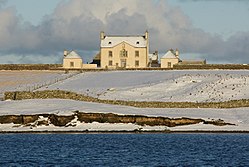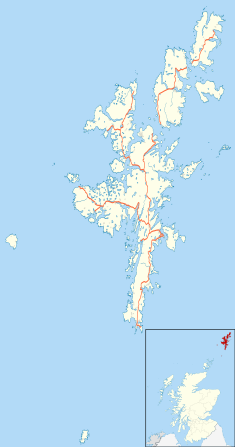Belmont House, Shetland
| Belmont House | |
|---|---|
 Belmont House | |
| Coordinates | 60°41′15″N 0°58′02″W / 60.6876°N 0.9673°W |
Listed Building – Category A | |
| Designated | 13 August 1971 |
| Reference no. | LB17474 |
| Criteria | Work of Art, Architectural |
| Designated | 31 March 2003 |
| Reference no. | GDL00054 |
Belmont House is a neo classical Georgian Country House Estate on the island of Unst, the most northerly of the Shetland Islands, [United Kingdom] and also of Scandinavia. It was constructed in 1775 by Shetland landowner Thomas Mouat of Garth who was a local Shetlander. The Estate has been described as "possibly the most ambitious, least-altered classical mansion in the Northern Isles."[1] The house was restored from a derelict state between 1996 and 2010 by the community and local interest groups and Trust. The house is now owned and run by Martin Wilson who uses the house as his home but also, from time to time, as a venue for events and for bed and breakfast.
Belmont House is protected as a category A listed building,[2] and the grounds are included on the Inventory of Gardens and Designed Landscapes in Scotland, the national listing of significant gardens.[1]
For holidays and events
[edit]Belmont House is almost exclusively a family home but is occasionally used by visitors and locals as a venue for bed and breakfast, short holidays, weddings, and other events. Income generated from room lets or functions is reinvested into maintaining the house and supporting the local community by allowing Open Days, Family BBQs and Picnics.
The house was restored from 1996 to 2010 to its original Georgian elegance but with the addition of modern amenities (fire alarm systems and sprinklers). It is fully furnished with Georgian furniture and original artworks, comfortable new beds and settees. The property can sleep up to 8 people in splendour. [citation needed]
Gardens
[edit]Walled gardens are laid out to the south of the house. These have been restored by The Belmont Trust with walls restored and trees and shrubs planted to form sheltered spaces to sit and enjoy the views over Bluemull Sound to the south. The gardens are open to the public.
History
[edit]Belmont was built in 1775, with the farm square to the rear complete by 1790; together they form “miniature Palladian classical groups with flanking pavilion wings” (ref Buildings of the Land: Scotland's farms 1750–2000, Miles Glendinning and Susanna Martins, ed Piers Dixon; RCAHMS 2008). Surrounding enclosures including garden grounds form a regular layout running down to the sea. The house and adjacent farm square are designated category A, and the grounds are included on the Inventory of Gardens and Designed Landscapes in Scotland.
The house was built for Thomas Mouat, whose father William was laird of the Garth estate in Shetland. Thomas visited Lothian, around Edinburgh, to gather ideas on contemporary architecture, and may have been influenced by Hopetoun House.[1]
In the early 19th century, the east wing was added to the house (now demolished), but otherwise, it has remained unaltered. The Mouat family continued to occupy the house until the mid-20th century. It was then sold and became derelict. [1] From 1996 and over the following 15 years works were carried out, largely by local craftsmen, to bring the building back into use. The property was sold in 2022 and is now a residential site occupied by Martin Wilson and Rufus the Retired Police (RPD) dog, with rooms set aside for Bed and Breakfast accommodation and evening meals .[3] The original interiors are described by Historic Scotland as "a particularly remarkable survival."[2]
References
[edit]- ^ a b c d Historic Environment Scotland. "BELMONT HOUSE (GDL00054)". Retrieved 11 January 2019.
- ^ a b Historic Environment Scotland. "BELMONT, BELMONT HOUSE... (Category A Listed Building) (LB17474)". Retrieved 11 January 2019.
- ^ "About the Belmont Trust". Belmont Trust. Archived from the original on 9 August 2011. Retrieved 25 August 2011.
External links
[edit]![]() Media related to Belmont House, Shetland Islands at Wikimedia Commons
Media related to Belmont House, Shetland Islands at Wikimedia Commons

